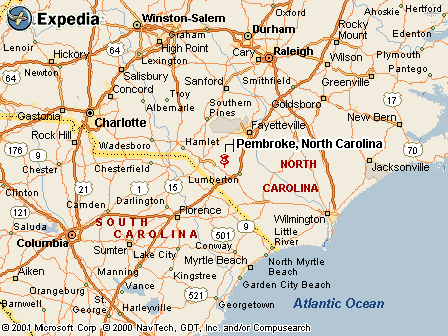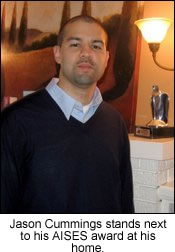 |
Canku Ota
|
 |
|
(Many Paths)
|
||
|
An Online Newsletter
Celebrating Native America
|
||
|
February 1, 2009 - Volume
7 Number 2
|
||
|
|
||
|
Schenectady man wins
top award from American Indian Science and Engineering Society
|
||
|
by Bill Buell - Schenectady
(NY) Gazette Reporter
|
||
|
“It’s tough being away from family, and the weather was a pretty big change, too,” said Cummings, who moved to Schenectady in 2006 after landing a job with IBM in Albany. “I have a little girl who wants to see her grandparents, and I know they want to see her.” Cummings, who turned 30 last May, is a member of the Lumbee and Coharie tribes of North Carolina. He is also a semiconductor development engineer, with a Ph.D. in chemical engineering from Princeton University and was recently named the American Indian Science and Engineering Society’s 2008 Professional of the Year. “Some of my co-workers brought the award to my attention back in the first quarter of the year, and they all felt I should apply for it,” said Cummings. “I had to produce five or six reference letters from my managers and other people. I also had to provide a bio of myself, a résumé and my job description. It got a little involved.” Cummings’ road to success has involved a number of trips north. As an 11th grader he left the public schools in Pembroke, N.C., and headed north to Durham and the North Carolina School of Science and Math for two years. For his undergraduate degree, he continued north up I-95 another hour or so and spent four years in Raleigh at North Carolina State. His graduate and doctoral degrees are both from Princeton University in New Jersey. “I think New Jersey was a good buffer between North Carolina and New York,” said Cummings, “but I think the weather and being away from family was the biggest challenge. But we found a nice house in Schenectady and we’re enjoying things very much. We still try to get back to North Carolina as often as we can.” Pembroke is a small city in Robeson County in southern North Carolina. It has a population of 2,399; 89 percent are American Indians. Cummings’ father, a Southern Baptist minister, is a member of the Lumbee tribe, and his mother is a member of the Coharie tribe. Both have often been identified with the Cherokee nation. “There was a strong identity and a strong connection to American Indian culture where I grew up,” said Cummings. “As kids we all had similar backgrounds, and I can’t say our public schools were great.” Fortunately, Cummings was able to attend the North Carolina School of Science and Math, a school for gifted students, for his last two years of high school. “That’s when I decided I wanted to get into engineering,” said Cummings, “and I chose chemical engineering over other disciplines because I felt like it took things from all disciplines of science and math and pulled them together. It seemed like a very broad field, involving plenty of math, physics and chemistry.” Cummings’ doctoral thesis focused on the interaction of microscopic membranes. His time at IBM, spent on “the ongoing development of antibiotics, particularly for HIV treatment and prevention,” is directly related to that work. His
wife, Synora, is a full Lumbi Indian, also from Pembroke, but the
couple were never formally introduced until they met in college.
While he was busy at N.C. State, she attended nearby Barton College
and became a social worker. She has worked at Catholic Charities
in Albany most of the past year, and the couple are expecting their
second child in the spring. They were married in 2003, and since
moving to Schenectady have attended the Trinity Baptist Church on
Balltown Road. More
than promising “Less than five years into my career, I thought most promising was the category to try for,” said Cummings. “I saw the credentials of some people who had won previous awards and they were very impressive. I thought maybe that I had a fighting chance at most promising engineer, but to win the overall award really surprised me. I didn’t expect that.” The other awards handed out by AISES, now in its 30th year, are Executive Excellence and Technical Excellence. Typically, it is the winner of one of those categories that gets elevated to professional of the year. “Most promising is for people within five years of receiving their most recent academic award,” AISES Executive Director Pamala Silas said earlier this month from the group’s headquarters in Albuquerque, N.M. “We’ve never elevated someone from that category before. But if you don’t look at the years and just Jason’s experience and accomplishments, he is the perfect example of the kind of role model our organization is looking for. He’s working with cutting-edge technology in Albany, but he’s also maintained a strong connection to the native community. That’s a very important part of our criteria.” Despite the demands of the job, Cummings and his wife find the time to keep their heritage a vital part of their lives for them, as well as their 2-year-old daughter, Eva. “There are American Indians all over the country, and since we’ve been to New York, we have spent some time seeking out other Indian communities and Indian people,” said Cummings. “We’re always looking for cultural events to attend, and remaining connected to Indian culture in general is very important to me.” One way Cummings has remained connected is by performing with the SilverCloud Singers, an intertribal American Indian singing and dance troupe based in New York City. “I’m part of a pow wow drum group that plays the Ho-Chunk style of Native American music,” said Cummings, referring to his contribution with the SilverCloud Singers. “I think the combination of my technical contributions with my career and my contributions to the native community definitely helped me win the award,” he said. “I had a good balance going. I’m doing a lot in my career, but I’m also doing a lot of things in my Native American community.” “Jason is proof that the native community can produce people who are very competitive and can be a wonderful resource for ongoing innovations in technology,” said Silas. “He’s a wonderful, comprehensive individual who has made an impact and values community. He knows where he came from.” |
 Pembroke, North Carolina map |
www.expedia.com |
|
|
||
|
|
||
| Canku Ota is a free Newsletter celebrating Native America, its traditions and accomplishments . We do not provide subscriber or visitor names to anyone. Some articles presented in Canku Ota may contain copyright material. We have received appropriate permissions for republishing any articles. Material appearing here is distributed without profit or monetary gain to those who have expressed an interest. This is in accordance with Title 17 U.S.C. Section 107. | ||
|
Canku Ota is a copyright ©
2000, 2001, 2002, 2003, 2004, 2005, 2006, 2007, 2008, 2009 of Vicki
Barry and Paul Barry.
|
||
 |
 |
|
|
The "Canku
Ota - A Newsletter Celebrating Native America" web site and
its design is the
|
||
|
Copyright ©
1999, 2000, 2001, 2002, 2003, 2004, 2005,
2006, 2007, 2008 of Paul C.
Barry.
|
||
|
All Rights Reserved.
|
||
 Other
than being the only two places in the world Jason Cummings calls
home, Pembroke, N.C., and Schenectady have very little in common.
Other
than being the only two places in the world Jason Cummings calls
home, Pembroke, N.C., and Schenectady have very little in common.